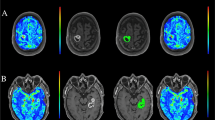Summary
Magnetic resonance (MR) images of 29 consecutive patients with intraspinal neoplasms (9 intramedullary tumors, 20 extramedullary tumors) were reviewed to evaluated the utility of MR imaging in distinguishing the intraspinal compartmental localisation and signal characteristics of each lesion. Compartment and histology of all neoplasms were surgically proven. MR correctly assigned one of three compartments to all lesions, 9 intramedullary, 14 intradural extramedullary (6 schwannomas, 3 neurofibromas, 5 meningiomas), and 6 extradural (3 schwannomas, 1 meningioma, 1 cavernous hemangioma, 1 metastatic renal cell carcinoma). All intramedullary tumors showed swelling of the spinal cord itself. In all five extradural tumors a low intensity band was visualized between the spinal cord and tumor. On the other hand, a low intensity band was demonstrated in no cases with intradural tumors. Visualization of this low intensity band is important in differentiating extradural from intradural-extramedullary lesions. We call this low intensity band, “the extradural sign”. Signal intensity of intradural tumors varied with histology. In extramedullary tumors, signal intensity of schwannomas was similar to that of the cerebrospinal fluid (CSF) both on T1 weighted (inversion recovery) and T2 weighted spin echo (SE) images. On the other hand, meningiomas tended to be isointense to the spinal cord on both T1 and T2 weighted SE images. We found relatively reliable signal characteristics to discriminate meningioma from schwannoma.
Similar content being viewed by others
References
Shapiro R (1975) Myelography, 3rd edn. Year Book Medical, Chicago
Delapaz RL, Brady TJ, Buonanno FS, New PFJ, Kistler JP, McGinnis BD, Pykett IL, Taveras JM (1983) Nuclear magnetic resonance (NMR) imaging of Arnold-Chiari type 1 malformation with hydromyelia. J Comput Assist Tomogr 7: 126–129
Modic MT, Weinstein MA, Pavlicek W, Starnes DL, Duchesneau PM, Boumphrey F, Hardy RJ Jr (1983) Nuclear magnetic resonance imaging of the spine. Radiology 148: 757–762
Modic MT, Weinstein MA, Pavlicek W, Boumphrey F, Starnes D, Duchesneau PM (1983) Magnetic resonance imaging of the cervical spine: technical and clinical observations. AJR 141: 1129–1136
Han JS, Kaufman B, El Yousef SJ, Benson JE, Bonstelle CT, Alfidi RJ, Haaga JR, Yeung H, Huss RG (1983) NMR imaging of the spine. AJR 141: 1137–1145
Norman D, Mills CM, Brant-Zawadzki M, Yeates A, Crooks LE, Kaufman L (1983) Magnetic resonance imaging of the spinal cord and canal: potentials and limitations. AJR 141: 1147–1152
Hyman RA, Edwards JH, Vacirca SJ, Stein HL (1985) 0.6 T MR imaging of the cervical spine: multislice and multiecho techniques. AJNR 6: 229–236
Dichiro G, Doppman JL, Dwyer AJ, Patrounas NJ, Knop RH, Bairamian D, Vermess M, Oldfield EH (1985) Tumors and arteriovenous malformations of the spinal cord: assessment using MR. Radiology 156: 689–697
Nakagawa H, Huang YP, Malis LI, Wolf BS (1977) Computed tomography of intraspinal and paraspinal neoplasms. J Comput Assist Tomogr 1: 377–390
Herdt JR, Shimkin PM, Ommaya AK, Dichiro G (1972) Angiography of vascular intraspinal tumors. Radiology 115: 165–170
Sze G, Brant-Zawadzki MN, Wilson CR, Norman D, Newton TH (1986) Pseudotumor of the craniovertebral junction associated with chronic subluxation: MR imaging studies 1. Radiology 161: 391–394
Soila KP, Viamonte M Jr, Starewicz PM (1984) Chemical shift misregistration effect in magnetic resonance imaging. Radiology 153: 819–820
Pech P, Haughton VM (1985) Lumbar intervertebral disk: correlative MR and anatomic study 1. Radiology 156: 699–701
Daniels DL, Kneeland JB, Shimakawa A, Pojunas KW, Schenck JF, Hart H Jr., Foster T, Williams AL, Haughton VM (1986) MR imaging of the optic nerve and sheath: correcting the chemical shift misregistration effect. AJNR 7: 249–253
Scotti G, Scialfa G, Colombo N, Landoni L (1985) MR imaging of intradural extramedullary tumors of the cervical spine. J Comput Assist Tomogr 9: 1037–1041
Rubinstein LT (1968) Tumors of the central nervous system. Atlas of tumor pathology. AFIP, Washington
Author information
Authors and Affiliations
Rights and permissions
About this article
Cite this article
Takemoto, K., Matsumura, Y., Hashimoto, H. et al. MR imaging of intraspinal tumors—Capability in histological differentiation and compartmentalization of extramedullary tumors. Neuroradiology 30, 303–309 (1988). https://doi.org/10.1007/BF00328180
Received:
Issue Date:
DOI: https://doi.org/10.1007/BF00328180




